
Why is there a higher chance of Down syndrome if a parent has a balanced translocation?
August 31, 2016

- Related Topics:
- Trisomy/Aneuploidy,
- Translocation,
- Chromosomes
An undergraduate from India asks:
"Why is there more of a chance for transmission of Down syndrome if one parent has a balanced translocation?"
In something like 96% of cases, Down syndrome is a random accident. Something happens while an egg is being made and that egg gets fertilized by a sperm. The end result is an extra chromosome 21 and a child with Down syndrome.
Or, less often, the reverse happens. There is a mix-up when a sperm gets made and this sperm then goes on to fertilize the egg.
In both these cases, the risks for the next baby having Down syndrome aren’t that much higher than typical. The usual number is a 1% risk or twice the risk for mom’s age, whichever is higher. The risk is so low because the extra chromosome is the result of a one-off accident.
Balanced translocations are a bit different. Women and, to a lesser extent, men can pass an extra chromosome onto their children, which means a higher risk for Down syndrome.
This happens even though the parents do not have Down syndrome themselves. They are silent carriers.
If a woman is a carrier for a balanced translocation that includes chromosome 21, then each of her children has about a 1 in 8 or 12% chance for ending up with Down syndrome. If a man is a carrier, this falls to around 3 in 100 or 3%.
Scientists aren’t really sure why there is a difference between men and women. Perhaps men have some way of weeding out the sperm that carry a translocation. Or maybe these sperm don’t get to the egg as quickly.
While we don’t know why men are less likely than women to pass it on, we do know why balanced translocations cause Down syndrome. It has to do with chromosomes.
DNA Is Packaged in Chromosomes
The instructions for making and running your body are found in long stretches of DNA called chromosomes. Most people have 23 pairs for a total of 46.
We each get one set of 23 chromosomes from one parent and the other set of 23 from the other. Here is what a full set of 46 chromosomes looks like:

These chromosomes are grouped into pairs. There is a pair of chromosome 1’s (upper left corner), a pair of chromosome 2’s next to the 1’s and so on down the line. One from each pair came from the mother and the other from the father.
It is really important that we have this exact number of chromosomes. Most humans who inherit 45 or 47 chromosomes don’t survive. And those that do often end up with conditions like Down syndrome (extra chromosome 21) or Turner syndrome (missing X chromosome).
Here is a set of chromosomes from someone with the most common form of Down syndrome, or Trisomy 21:
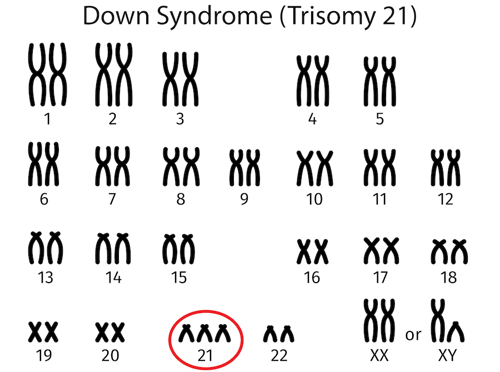
Note the extra chromosome 21. This extra chromosome upsets the balance of information, which leads to the symptoms associated with Down syndrome.
But sometimes having 45 chromosomes has no obvious effect. Like when two chromosomes end up stuck together.
Now no information is lost. Here is an example of one of these balanced translocations:
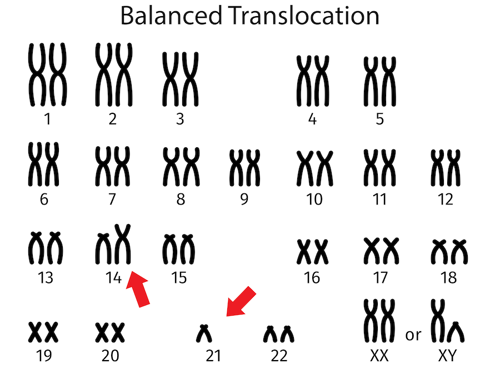
Looking at the red arrows you can see that the missing chromosome 21 has moved and is attached to a chromosome 14. This person hasn’t lost a significant amount of information, so they may not have any symptoms even though they have 45 chromosomes instead of 46.
Even though this person may not have any symptoms, or even know that they have a balanced translocation, they could see the effects of this translocation if they had a child.
This carrier and their partner are much more likely to have a pregnancy that ends in miscarriage. In the next section I’ll explain why.
Passing Down Chromosomes
When a person has a child they pass down one chromosome from each of their 23 pairs. The mother passes down one of her chromosome 1’s, one of her 2’s, and so on. The father does the same. In the end, the child has two of each of the 23 chromosomes for a total of 46.
Let’s look at this process in a little more detail. I’ll focus on just two pairs.
Imagine this is the mother’s two pairs of chromosomes:
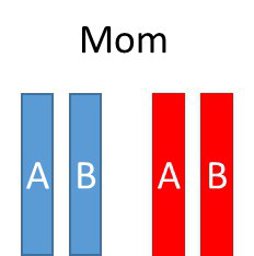
I’ve made one pair blue and one pair red to make them easier to follow. I have also given an A or a B to each one in a pair to make them easier to track.
Next let’s add the father’s chromosomes to the equation:
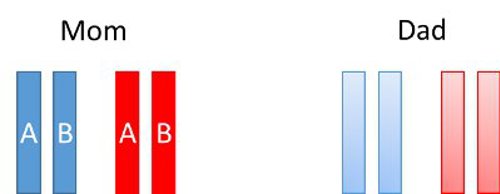 Notice his chromosomes are the same colors. So he has a pair of blue chromosomes that corresponds to the mother’s blue pair, and a pair of red chromosomes that corresponds to the mother’s red pair. Since we will be focusing on the mother’s, we haven’t given the father’s any letters.
Notice his chromosomes are the same colors. So he has a pair of blue chromosomes that corresponds to the mother’s blue pair, and a pair of red chromosomes that corresponds to the mother’s red pair. Since we will be focusing on the mother’s, we haven’t given the father’s any letters.
Here is one possibility if they have a child:
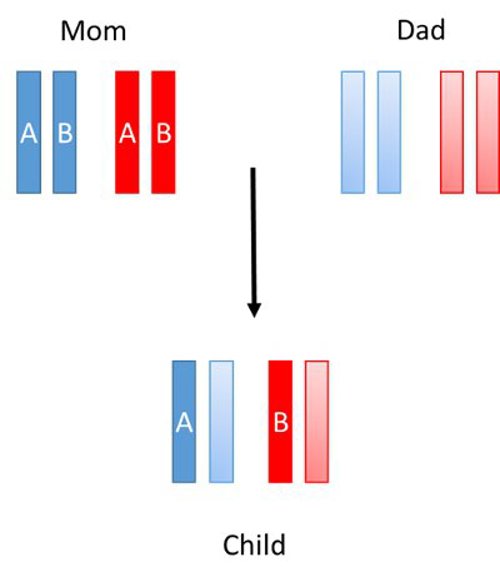 As you can see, each parent passed one of their blue chromosomes and one of their red ones. By chance, the mother happened to pass on blue chromosome “A” and red chromosome “B.”
As you can see, each parent passed one of their blue chromosomes and one of their red ones. By chance, the mother happened to pass on blue chromosome “A” and red chromosome “B.”
The child could have also gotten a blue B and a red A, a blue B and a red B, and so on. There are four possible combinations for the mother’s chromosomes.
Whichever combination the child gets from each parent, he or she still has two blue chromosomes and two red. The child has a complete set of information.
Things get tricky if one parent has a translocation. Let’s say the mother has a balanced translocation, and her red chromosome “A” is stuck to blue chromosome “B”:

As you can see she has all of her information, it is just arranged differently.
Now we can add the father back in again:
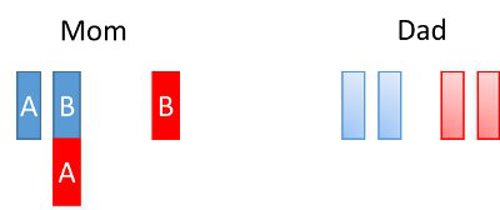
Now let’s see what could happen if they were to have a child:
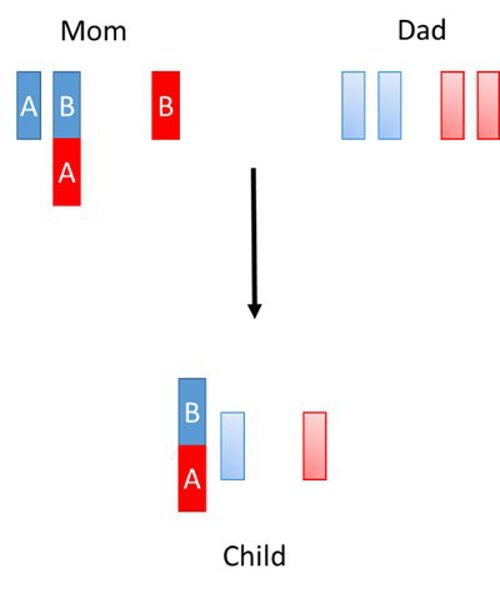
So what happened here? The father still passed on one of each of his chromosomes.
From the first pair, the mother passed on the blue chromosome that had the red chromosome stuck to it. And from the second pair, she happened to pass the empty spot--she didn’t pass on any chromosome at all.
Like the mother, the child still has the right amount of information: two red and two blue chromosomes’ worth. It is just arranged differently than in most people.
Here is another possibility:
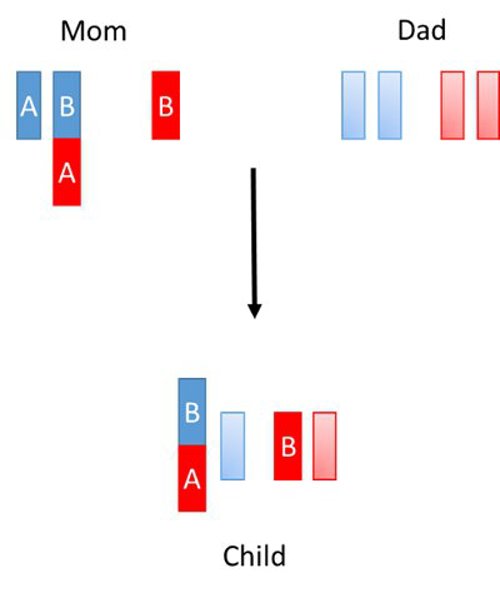 In this case the mother again passed on the blue chromosome that had the red chromosome “A” stuck to it. But she also passed her the “B” copy of her red chromosome. The father, as usual, passed one of each.
In this case the mother again passed on the blue chromosome that had the red chromosome “A” stuck to it. But she also passed her the “B” copy of her red chromosome. The father, as usual, passed one of each.
This child now has three copies of the red chromosome. If the red chromosome was chromosome 21, the child would have Down syndrome.
If it was a different chromosome, like 14 or 15 (which are often involved in these sorts of translocations), the result would likely be a miscarried pregnancy. The child could not survive with all of that extra information.
Additionally, the mother could pass on the blue “A” chromosome and nothing from the red pair, resulting in the following:
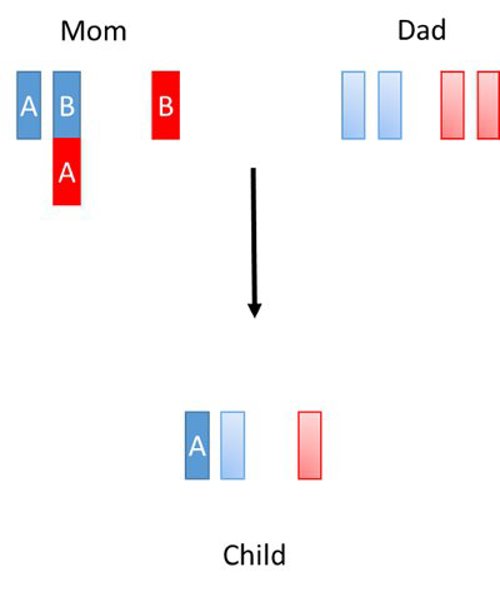
Now the child is missing some information. A missing chromosome is almost always lethal (except in the case of a child who is born with a single X chromosome).
It is also possible that the child gets the blue “A” chromosome and red “B” chromosome from the mother, and has just the right amount information packaged in the usual way:
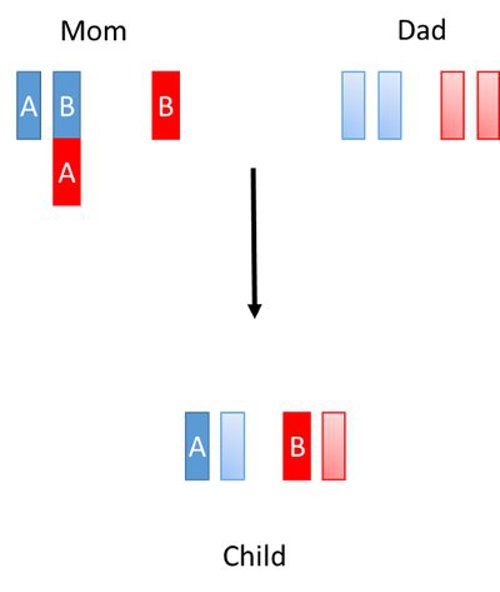
This is why a parent who is a carrier of a balanced translocation involving chromosome 21 is at a higher risk for having a child with Down syndrome. Sometimes they will pass down a combination of chromosomes that have the same effect as having an extra chromosome 21.

Author: Dr. D. Barry Starr
Barry served as The Tech Geneticist from 2002-2018. He founded Ask-a-Geneticist, answered thousands of questions submitted by people from all around the world, and oversaw and edited all articles published during his tenure. AAG is part of the Stanford at The Tech program, which brings Stanford scientists to The Tech to answer questions for this site, as well as to run science activities with visitors at The Tech Interactive in downtown San Jose.
 Skip Navigation
Skip Navigation
